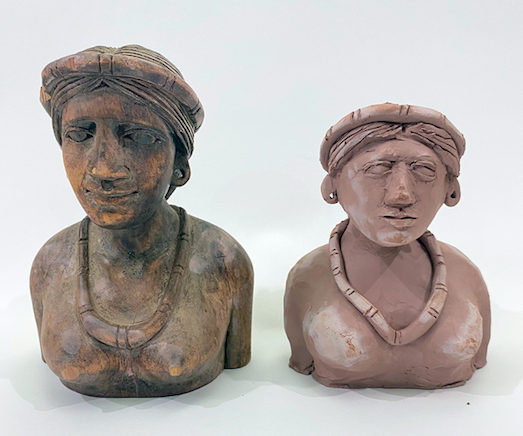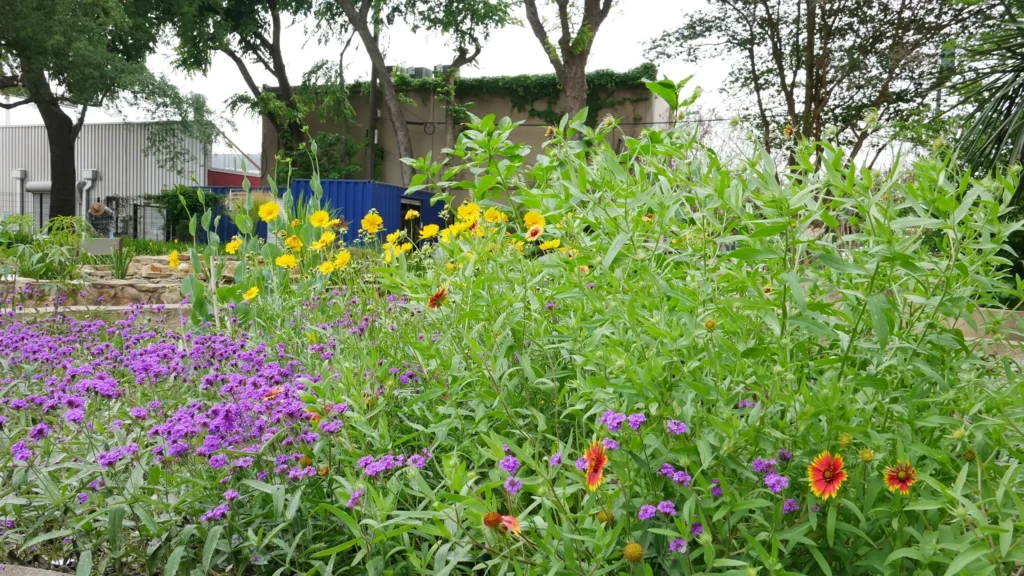The Manila-born sculptor traces his roots in a new solo exhibit at the Houston Center for Contemporary Craft.
By Robert Boyd

What inspires a person to become an artist? Ask Matt Manalo, and he’ll talk about the mural painters he remembers from his childhood in Manila. “I have this very vivid image of folks climbing scaffolding made of bamboo,” says the Philippines-born, now Houston-based artist. “They would be painting these giant movie posters, mural-size. I remember sitting back in the car in traffic watching these guys painting these figures and the titles of the movies. They did it so fast and so beautifully.”
Nineteen years ago, Manalo immigrated from the Philippines to the United States—specifically to the Houston neighborhood of Alief. He was 19 years old. Now 38, he’s officially spent half his life in the Philippines and half in the United States. Manalo examines his voyage from there to here in his sculptural installation “38,” part of his new solo exhibit Philippine-Made, currently on view at the Houston Center for Contemporary Craft.
The piece consists of 38 small sculptures, each on its own shelf, each sculpted out of air-dry clay. They’re all modeled on one original: a bust of a woman, displayed to the side of the copies. The artist spent an hour sculpting each. Some are pretty good duplicates of the original. Some are incomplete. One hasn’t been worked at all—it’s just a rectangular chunk of clay. But in most of the duplicates, Manalo gets the details right.
The original, which represents an indigenous Igorot person, is a souvenir from the Philippines that Manalo bought in Houston in a thrift store. It is, like Manalo, an immigrant. In addition to reflecting his own life’s journey through time and through space, it also symbolizes the occupation of the Philippines by colonial powers of Spain and the United States.
Manalo was born in Manila in 1984. He lived what many would think of as a privileged life. “When I was living in the Philippines, we had folks do everything for us,” he says. “We had maids, a driver, and all that. It was a different life.”

Manalo was interested in art, but his high school did not have art instruction. “We had shop,” he says. “There was woodworking, metal-working. I was introduced to screen printing. Weaving even. Those were things that I really enjoyed doing in school.” That focus on practical skills done by hand would inform his own artistic practice. One of the pieces in Philippine-Made, “Gaze,” is an image of himself projected onto a hand-woven mat made of lemongrass, harvested from the “craft garden” of HCCC. It was important to Manalo that the pieces in this exhibit be made of sustainable materials. In addition to lemongrass, he sourced bamboo for his piece “Hang Low (pabitin).”
Manalo’s mother got a teaching job in Houston, leading the family to relocate. Even though Manalo was 19 when they arrived, he still had growing up to do. He no longer had a cook and driver. “I was mad at my parents,” he says. “You brought me here and didn’t even teach me how to use a rice cooker?” And beyond that, he now had to pick a career.
“I thought the career for me was nursing, because all my relatives are nurses,” Manalo says. But after taking some prerequisites, he realized he was too squeamish for that line of work. “I can’t stand to see someone with a dangling arm because it’s broken.” With his parents’ support, Manalo chased his creative interests instead, and ended up studying art at the University of Houston. There was no looking back.
Since Manalo graduated in 2011, his work has been displayed in some of Houston’s best alternative art spaces, like the Joanna, Skydive, Box 13 Artspace, El Rincon Social, and others. Much of it has addressed his Philippine background and the history of his home country. It tends to have a three-dimensional presence, even when hung like a painting, though Manalo occasionally works with just ink or paint, too.
In 2019, Manalo got a grant through the DiverseWorks Project Freeway Fellowship to establish an art gallery in Alief, where his family moved so many years earlier. Initially, his plan was to buy an outdoor shed—the kind one might purchase at Home Depot—but that turned out to be too expensive for his stipend. Instead, he spent $1,500 on a used shipping container to serve as what would become the Alief Art House.
Alief, like many Houston neighborhoods, is an art desert. Seeing it requires a trip inside the 610 Loop, where most of Houston’s art museums and galleries are. Manalo wanted something accessible to his community, in multiple respects.
“Thinking about what accessible means—is it they don’t go there because they worry that they have to pay an entrance fee? Or are they intimidated because they just don’t know anything about art?” Manalo muses. He speculates that many people don’t get involved in art because the institutions are daunting. “I think the architecture of the building is intimidating. The idea that you can’t touch things, or that you have to dress up. Or you won’t understand anything that’s written on the wall text. Or the security guards are following you around. These are a lot of the things that would make it less accessible to folks who are immigrants or who don’t have English as their first language.”

The Alief Art House has featured exhibits, installations, a mural made of native plants, and community activities. It recently received a grant from Smithsonian Asian Pacific American Center to plant its own craft garden, inspired by the one at HCCC. “For me, making that space in Alief, I realized that there are artists here,” explains Manalo. “It’s just that there wasn’t a place to convene, to talk about art, or display art. That was a big discovery for me was that there were people like me! We just didn’t know we existed.”
Gathering people together was also the point of Filipinx Artists of Houston, which Manalo also founded in 2019. He had been invited to attend the opening of an exhibit, Super Sarap, at the Asia Society Texas that featured art by Filipino Americans. A conversation with the curator, Bridget Bray, inspired Manalo to put out a call on social media for Filipino American artists to meet. The turnout surprised him: Over 40 people showed up, many of whom he had never met. Filipinx Artists of Houston, which grew out of that gathering, includes visual, performing, literary, culinary, and multidisciplinary artists.
Alief Art House and Filipinx Artists of Houston were both born of Manalo’s commitment to finding and building a community. Philippine-Made is more personal. The pieces reflect his own journey from the Philippines to Houston. They all feature either some artifact from the Philippines (the souvenir statuette in “38,” handmade placemats in “No Partaking”) or refer to something Filipino. “Hang Low (pabitin)” uses a grid made of bamboo sourced from the craft garden to duplicate a children’s game from the Philippines called pabitin. The bamboo grid is hung with little bags of treats; the object of the game was for kids to jump up and grab them off the bamboo. On one of the pieces of bamboo, Manalo has carved a line of poetry from the poem “Pigeons For My Son” by Mila Aguilar. It reads: “Why cage pigeons who prefer free flight In the vaster, bluer skies?”
The words were composed by Aguilar when she was a political prisoner during the Marcos regime in 1984—the same year Manalo was born. Like Manalo himself, this line of poetry took 38 years to get here.
Philippine-Made is on display at the Houston Center for Contemporary Craft until May 13. Visit the website for more information.
